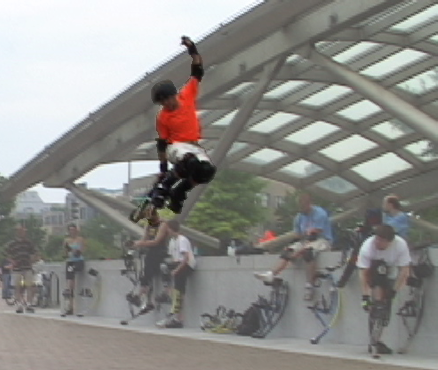|
Flybar 1200
:''Flybar may also refer to an element of the helicopter rotor.'' The Flybar is a modification of the traditional pogo stick design which allows riders to propel themselves up to a world record 8 feet 6 inches into the air according to the Flybar's website. Developed in a collaborative effort between SBI Enterprises, Bruce Middleton and Andy Macdonald, it utilizes in place of the usual steel spring in a regular pogo stick 12 elastic bands used for propulsion, also known as thrusters. It weighs 20 pounds (9 kilograms) and is capable of producing up to 1,200 pounds-force (5,300 newtons) of thrust. The Flybar comes in another model, the Flybar 800, which is intended for lighter people. See also * Stunt Pogo * Pogo Stick * Vurtego * Powerbocking Jumping stilts, bounce stilts or spring stilts are special stilts that allow the user to run, jump and perform various acrobatics. Spring stilts using fiberglass leaf springs were patented in the United States in 2004 under the tra ... [...More Info...] [...Related Items...] OR: [Wikipedia] [Google] [Baidu] |
Helicopter Rotor
A helicopter main rotor or rotor system is the combination of several rotary wings (rotor blades) with a control system, that generates the aerodynamic lift force that supports the weight of the helicopter, and the thrust that counteracts aerodynamic drag in forward flight. Each main rotor is mounted on a vertical mast over the top of the helicopter, as opposed to a helicopter tail rotor, which connects through a combination of drive shaft(s) and gearboxes along the tail boom. The blade pitch is typically controlled by the pilot using the helicopter flight controls. Helicopters are one example of rotary-wing aircraft (rotorcraft). The name is derived from the Greek words ''helix'', helik-, meaning spiral; and ''pteron'' meaning wing. Design principles Overview The helicopter rotor is powered by the engine, through the transmission, to the rotating mast. The mast is a cylindrical metal shaft that extends upward from—and is driven by—the transmission. At the top of the mast i ... [...More Info...] [...Related Items...] OR: [Wikipedia] [Google] [Baidu] |
Pogo Stick
A pogo stick is a device for jumping off the ground in a standing position, through the aid of a spring, or new high performance technologies, often used as a toy, exercise equipment or extreme sports instrument. It led to an extreme sport named extreme pogo or "Xpogo". It consists of a pole with a handle at the top and footrests near the bottom, and a spring located somewhere along the pole. The spring joins two sections of the pole, which extends below the footpads. The jumper places their feet on the footpads while balancing on the pole, then jumps up or down with a bending action of the knees to add or subtract energy in the spring. When the spring is at full compression or extension, the jumper is lifted by the recoil of the spring, being launched several inches or feet into the air. This process is repeated to maintain a periodic bounce. The pogo stick can be steered by shifting one's weight off the centerline of the spring in the desired horizontal direction thus produc ... [...More Info...] [...Related Items...] OR: [Wikipedia] [Google] [Baidu] |
Andy Macdonald (skateboarding)
Andy Macdonald (born July 31, 1973) is an American professional skateboarder. As of September 2013, he holds the record for the most X Games medals in vert skateboarding and won the World Cup Skateboarding competition eight times. Early life Macdonald is originally from Melrose, Massachusetts, and started skateboarding in 1986 when he was 12 years old. He graduated from Newton North High School in 1992. Professional skateboarding Macdonald became a professional skateboarder in 1994. In 1998 he was selected the "Best Overall Skater" in the "Readers Poll" of ''Transworld Skateboarding'' magazine, and was also chosen to host ''Transworlds skateboarding "Trick Tip" video, '' Starting Point 2: Transitions''. He has received praise for his perennial consistency as he medals in most of the competitions he enters, even beating out a lot of younger skateboarders. In 1999 Macdonald delivered an anti-drug speech at the White House that was preceded by Macdonald skateboarding down the ma ... [...More Info...] [...Related Items...] OR: [Wikipedia] [Google] [Baidu] |
Pounds-force
The pound of force or pound-force (symbol: lbf, sometimes lbf,) is a unit of force used in some systems of measurement, including English Engineering units and the foot–pound–second system. Pound-force should not be confused with pound-mass (lb), often simply called ''pound'', which is a unit of mass, nor should these be confused with foot-pound (ft⋅lbf), a unit of energy, or pound-foot (lbf⋅ft), a unit of torque. Definitions The pound-force is equal to the gravitational force exerted on a mass of one avoirdupois pound on the surface of Earth. Since the 18th century, the unit has been used in low-precision measurements, for which small changes in Earth's gravity (which varies from equator to pole by up to half a percent) can safely be neglected. The 20th century, however, brought the need for a more precise definition, requiring a standardized value for acceleration due to gravity. Product of avoirdupois pound and standard gravity The pound-force is the product ... [...More Info...] [...Related Items...] OR: [Wikipedia] [Google] [Baidu] |
Newton (unit)
The newton (symbol: N) is the unit of force in the International System of Units (SI). It is defined as 1 kg⋅m/s, the force which gives a mass of 1 kilogram an acceleration of 1 metre per second per second. It is named after Isaac Newton in recognition of his work on classical mechanics, specifically Newton's second law of motion. Definition A newton is defined as 1 kg⋅m/s (it is a derived unit which is defined in terms of the SI base units). One newton is therefore the force needed to accelerate one kilogram of mass at the rate of one metre per second squared in the direction of the applied force. The units "metre per second squared" can be understood as measuring a rate of change in velocity per unit of time, i.e. an increase in velocity by 1 metre per second every second. In 1946, Conférence Générale des Poids et Mesures (CGPM) Resolution 2 standardized the unit of force in the MKS system of units to be the amount needed to accelerate 1 kilogram of mass at the rate ... [...More Info...] [...Related Items...] OR: [Wikipedia] [Google] [Baidu] |
Stunt Pogo
Extreme Pogo or Xpogo is an action sport which involves riding and performing tricks on specially designed "extreme" pogo sticks. These pogo sticks have the potential for jumping over 3 meters in height. Xpogo can be seen in athlete exhibition teams, Xpogo content on sites such as YouTube, and the annual Pogopalooza: The Xpogo World Championship Series. Xpogo competitions have begun in countries outside of the US. An Xpogo commercial was run by Nike during the 2012 Summer Olympics. Xpogo athletes were included in the 2014 Rose Parade The Rose Parade, also known as the Tournament of Roses Parade (or simply the Tournament of Roses), is an annual parade held mostly along Colorado Boulevard in Pasadena, California, United States, on New Year's Day (or on Monday, January 2 if N ... in Pasadena, California. The vast majority of Xpogo athletes are male and between the ages of 10 and 25. History Beginnings The beginnings of Xpogo are contested, but it is acknowledged among the Xpog ... [...More Info...] [...Related Items...] OR: [Wikipedia] [Google] [Baidu] |
Pogo Stick
A pogo stick is a device for jumping off the ground in a standing position, through the aid of a spring, or new high performance technologies, often used as a toy, exercise equipment or extreme sports instrument. It led to an extreme sport named extreme pogo or "Xpogo". It consists of a pole with a handle at the top and footrests near the bottom, and a spring located somewhere along the pole. The spring joins two sections of the pole, which extends below the footpads. The jumper places their feet on the footpads while balancing on the pole, then jumps up or down with a bending action of the knees to add or subtract energy in the spring. When the spring is at full compression or extension, the jumper is lifted by the recoil of the spring, being launched several inches or feet into the air. This process is repeated to maintain a periodic bounce. The pogo stick can be steered by shifting one's weight off the centerline of the spring in the desired horizontal direction thus produc ... [...More Info...] [...Related Items...] OR: [Wikipedia] [Google] [Baidu] |
Vurtego
] Vurtego or Vurtego Pogo Sticks are a variation of the traditional pogo stick in which the spring mechanism used for jumping is air, as opposed to a traditional metal coil spring. They are designed as a high-end pogo stick, capable of jumping to extreme heights and enabling riders to perform a wide variety of tricks. There are a variety of advantages in using an air-powered pogo stick, ranging from adjustable spring tensions to overall weight to power ratio. The air spring within a Vurtego pogo stick allows riders to pump the pogo stick up to their own preferred air pressure in order to jump. The more air pressure that is pumped into the pogo stick, the stiffer the spring becomes. The same Vurtego pogo stick can be used by a 75 lb kid or a 300 lb fully grown adult, simply by adjusting the air pressure. Due to the air spring that is used in the Vurtego's pogo sticks, there is no maximum weight limit. An air spring has advantages over other forms of pogo stick propulsio ... [...More Info...] [...Related Items...] OR: [Wikipedia] [Google] [Baidu] |
Powerbocking
Jumping stilts, bounce stilts or spring stilts are special stilts that allow the user to run, jump and perform various acrobatics. Spring stilts using fiberglass leaf springs were patented in the United States in 2004 under the trademark "PowerSkip", marketed for recreational and extreme sports use. Spring stilts are often mostly made of aluminium. Using these stilts is also called "bocking" or "powerbocking", a corrupted version of the name of the stilts' inventor, Alexander Böck. Powerbocking The act of "bocking" or "powerbocking" includes jumping, running, and performing acrobatics with elastic-like spring-loaded stilts. They can be used to jump great distances and allow the user to bounce over people and cars and to perform backflips. For some, it is an extreme sport; for others, it is a form of exercise, artistic expression and a form of entertainment. The stilts are often referred to generically as bocks or powerbocks; as power stilts, jumping stilts, bounce stilts or ... [...More Info...] [...Related Items...] OR: [Wikipedia] [Google] [Baidu] |





